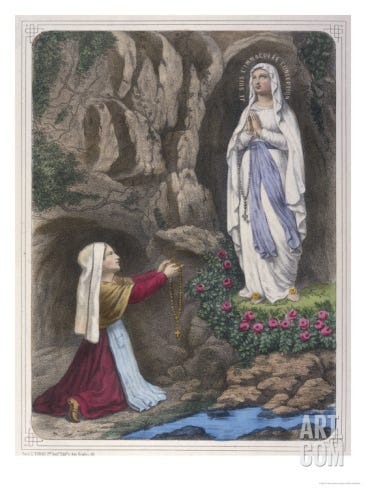Today is the feast of Our Lady of Lourdes, the commemoration of the Blessed Mother’s appearance near Lourdes, France, to the young Bernadette Soubirous.
Bernadette came from a poor family. She had little education, partly due to poverty and partly to ill-health. She suffered from asthma and other ailments, and contracted cholera in the 1854 cholera epidemic.
The 14 year old Bernadette was about a mile from home, collecting firewood with her sister and a friend, when a “lady” spoke to her in the cave at Massabielle. Initially, Bernadette tried to keep the apparition a secret, but her friend told her mother. When Bernadette’s parents questioned her and her sister, they told their story to the disbelief of their parents. The story goes that they were punished for this and forbidden to return to the grotto.
On February 14, Bernadette, armed with holy water, went back to the cave. When the lady appeared, Bernadette tossed the holy water at her and demanded that the lady leave unless she was from God. According to Bernadette, the lady smiled and bowed. Bernadette continued to visit the lady, despite her parents objections and the subsequent drama surrounding the apparitions - disbelief from villagers, the government fencing off the area, the Church’s hands off approach.
On one visit, the lady asked Bernadette to dig in the dirt and drink from the spring that appeared. This spring became one of the focal points of the site as miraculous healings were attributed to its waters.
Eventually, an investigation was done, a church was built, the apparition and the site were officially approved by the Church, several healings were deemed miraculous, and Bernadette was declared a saint.
Today, Lourdes is a major pilgrimage site, hosting thousands and thousands of visitors, who dip into its pools of spring water for healing.
There were 18 apparitions in total from February 11, 1858 until July 16, 1858.
On March 25 (Feast of the Annunciation), Bernadette snuck into the barricaded site, determined to find out the lady’s name so that she could share it with her priest, Fr. Peyramale. One of the things I like about Bernadette is that she could be stubborn. On every visit, she asked the lady her name, despite getting no direct answer.
On the March 25th visit, she asked again and again and again, until finally at the fourth request, the lady said, “que soy era immaculada concepciou,” I am the Immaculate Conception.
Four years earlier, in 1854, Pope Pius IX declared the Immaculate Conception as one of the four Marian dogmas of the Catholic Church in the papal bull, Ineffabilis Deus, stating: We declare, pronounce, and define that the doctrine which holds that the most Blessed Virgin Mary, in the first instance of her conception, by a singular grace and privilege granted by Almighty God, in view of the merits of Jesus Christ, the Saviour of the human race, was preserved free from all stain of original sin, is a doctrine revealed by God and therefore to be believed firmly and constantly by all the faithful.
The Immaculate Conception was a hotly contested issue, argued by theologians for centuries until Pius’ declaration. But the 1850’s were not like today when every utterance of the pope can be found online and so for Bernadette to know that title of Our Lady would have been unlikely, if not impossible.
When she told the priest what the lady had said, he questioned her several times, shaken that she knew the title, that she stuck with her story, that, it seemed, the Blessed Mother was appearing in his village to this poor, illiterate, peasant girl who had not even received her first communion yet.
“She could not have invented this…” Fr. Peyramale wrote to this bishop that evening.
Bernadette entered the Convent of the Sisters of Mercy in Nevers on July 7, 1866, taking the name Marie Bernard. She died in 1879, was beatified in 1925 and canonized on the Feast of the Immaculate Conception, December 8th, in 1933.
My confirmation name is Bernadette. I’d share a picture if I could find one, but, I cannot. Here’s a photo of my parish in Overbrook, Our Lady of Lourdes:




